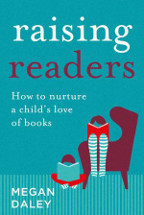Raising readers: How to nurture a child's love of books by Megan Daley

UQP, 2019. ISBN: 9780702262579. 244pp., pbk.
(Teacher reference, Parents) In the early days of European
settlement in this country, establishing schools became a priority
particularly for those with a religious bent because they believed
it was imperative that the emerging generation of children be able
to read and understand The Bible and thus not follow their parents'
errant ways. That was a school's key purpose. Decades and
generations on and while society has changed, and schools themselves
are almost unrecognisable from those early institutions, the
expectation that a child primarily attends so they can learn to read
has not.
Right from preschool children are tested on their literacy
development and judged according to it, underlining the importance
that is still placed on being able to read and write. Five year olds
head off on their first day of 'big school' fully expecting to be
able to read by the time they come home and are often disappointed
that they cannot. However, research and experience has shown that
schools alone cannot be the child's primary teachers in this
critical endeavour. It is a partnership between home and school and
those who make the best readers are those whose roots in reading
extend back to birth. Indeed, author Mem Fox has stated that the
illiteracy problem in this country could be solved if children just
heard 1000 stories before they come to school (which can be achieved
in three years with a favourite, a familiar and a first-read as the
regular bedtime routine) and the concept of the 'million
word gap' is not new.
So this book from Megan Daley, a respected, qualified teacher
librarian (we must have qualifications in both teaching and
librarianship), which explores how parents can help to raise readers
is a valuable contribution to the lives of new parents, particularly
in these days of the screen being a dominant feature in children's
lives. For those who can read it is hard to remember not being
able to do so; for those who can't read or don't like to it is
tricky to overcome the personal prejudices that already exist, so to
have a 'manual' that helps explain some of the best practices and
what underlies them is eye-opening.
While there have been a number of books on this sort of topic in the
past, many have been written by either authors of children's books
or university lecturers. This one is by a practising teacher
librarian who is in touch with what is happening both in and out of
school as Megan has two daughters. She examines the place of the
school library in the child's reading journey while at the same time
encouraging parents to attend book launches; getting involved in
Book Week while setting up a book-themed bedroom; explaining the
most popular genres of young readers while offering tips to host
book parties and be 'best book-givers'. Interspersed with the
user-friendly text are comments from some of Australia's favourite
children's authors as well as suggestions for books to support the
young reader as they grow their literacy skills.
For the teacher and the teacher librarian, this is a refreshing read
with lots of tried-and-true and new ideas and perspectives in
amongst the host of academic and professional reading we have to do;
to parents it's a simple explanation of the what, why and how of
raising a reader so both child and parent fulfil their expectations.
One to encourage staff to read and to include and promote in your
parent library.
Barbara Braxton